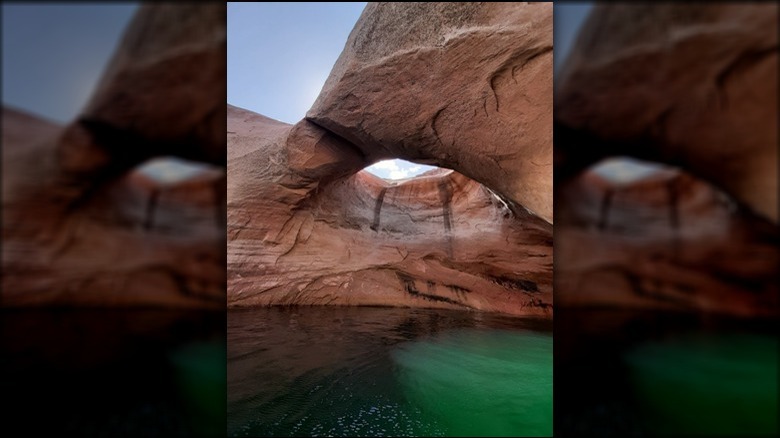This Millions-Of-Years-Old, Famed National Landmark In Utah Has Collapsed
A section of southern Utah's signature sandstone collapsed in the early afternoon of Thursday, August 8, 2024. The rock, officially known as Double Arch and also referred to as "Toilet Bowl," "Crescent Pool," or "Hole in the Roof," was a popular attraction in the Glen Canyon National Recreation Area, which is filled with otherworldly scenery in Utah. No one was injured when chunks of the formation fell into the waters of Rock Creek Bay, despite video showing people playing nearby moments earlier.
Eyewitness footage obtained by KSL 5 TV captured boaters and swimmers leaping off the formation on the same day that it collapsed. Another person at the scene told KSL he saw a "Volkswagon-sized rock" surrender to gravity, and a separate video showed a massive off-camera splash sending spray skyrocketing up from the water. The mesmerizing natural wonder that collapsed is not the same as the other famous Double Arch in the Windows area of Arches National Park, which is the largest in the park and remains intact.
Regardless of where an event like this happens, these moments remind us to appreciate all of our natural resources before they, too, fade away. The Navajo sandstone that made up this formation has been estimated to be 190 million years old. From one day to the next, it's gone. While geologists seek to understand exactly how this particular arch fell, officials are urging visitors to leave no trace and take no chances to ensure we can preserve the natural monuments still standing for as long as possible.
How did the Double Arch collapse?
In a prepared statement, Glen Canyon National Recreation Area Superintendent Michelle Kerns said, "We don't know what caused this collapse." However, the eventual demise of this monument had been written since its beginning. Arches are created by millennia of weathering and erosion. The same natural processes that created this arch eventually destroyed it. National Park Service (NPS) officials said this arch was "subject to spalling and erosion from weather, wind, and rain" since it first formed in the early Jurassic period. The final straw just happened to hit the camel's back last Thursday. Officials also believe that the waters and gentle waves of man-made Lake Powell, which provides drinkable water to over 40 million people, contributed to the arch's slow and steady downfall.
As Chinua Achebe taught us, things fall apart. A U.S. geological survey of the Arches National Park region concluded that even without human interference, none of the 2,000 arches within the national park are permanent structures. The region's rainfall patterns will result in year-round erosion that will eventually destroy all standing arches and create new ones. In an ode to fallen arches, the NPS called nature the ultimate Etch-A-Sketch, explaining that "for any future wonders to become reality, the park as we know it today has to crumble away first." In a certain sense, the arch has not collapsed; it has become rocks gathering algae at the bottom of Lake Powell.
This isn't the first time an arch has fallen in Utah
In 2008, chunks of rock smashing into the ground woke up nearby campers when Wall Arch collapsed in Arches National Park, an underrated Utah park with iconic views. The 71-foot gap had once been the park's 12th-largest arch. More recently, the Rainbow Arch collapsed during the winter of 2017-2018. Research teams had been monitoring the area after noticing a large crack in the structure.
While the sharpness of a collapsing arch — here for millions of years, crashing down in moments — can feel unnatural, officials say that a dramatic exit is a natural part of an arch's lifespan. Parks spokesperson Karen Garthwait told the Salt Lake Tribune, "The great thing about geology is that it happens extremely slowly — except for when it doesn't." Garthwait said that arch failure is natural, and the park service does not intervene to prevent arches from collapsing.
Humanity's responsibility to preserve arches has been debated as early as the late 1940s when Arches National Park custodians noticed erosion eating away at Delicate Arch. Officials discussed various solutions to preserve the landmark, including spraying the arch with silicone. At the time, the NPS advisory board opposed stabilizing geological structures in parks, and another dissenter argued that there was a very real possibility that human intervention would lead to more harm than good. Ultimately, nothing was done, and that precedent continues to this day. Garthwait concurs with the decision, explaining that the mission of the NPS "isn't to stop time."


